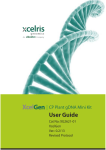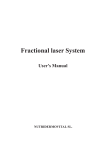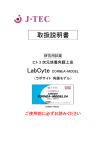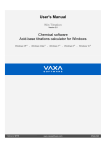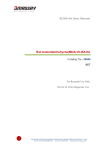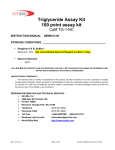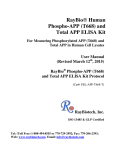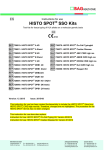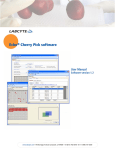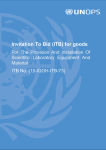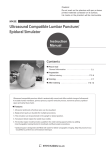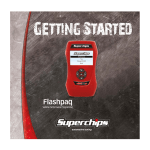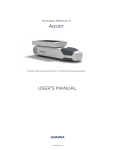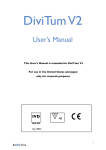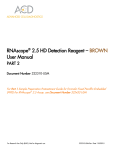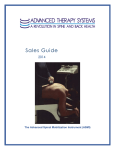Download LabCyte EPI
Transcript
User’s Manual LabCyte EPI-MODEL Three-dimensional Cultured Human Epidermis Model For Research Use Only EPI-MODEL 24 EPI-MODEL 12 Please read this manual before use. 1 Table of Contents I. Characteristics of LabCyte EPI-MODEL II. Components of the Kit III. Handling Suggestions and Precautions IV. How to Use – Standard Protocol of In Vitro Skin Irritation Test V. Basic Precautions 2 Thank you for purchasing "LabCyte EPI-MODEL" (3-D Cultured Human Epidermis Model). Please read this manual before use. I. Characteristics of LabCyte EPI-MODEL "LabCyte EPI-MODEL" is a 3-dimensional reconstructed human epidermis model, produced by culturing normal human epidermal cells to become multilayered. The structure of "LabCyte EPI-MODEL" is morphologically similar to that of human epidermis, consisting of the basal layer, the spinous layer, the granular layer and the stratum corneum. This product could be used as an alternative to experimental animals mainly for skin irritation tests, and for the human epidermis-related researches such as toxicology, pharmacology and dermatology as well. This product is produced by our advanced techniques of culturing epidermis, which enables to gain highly-reproducible results in evaluation tests with less variation between each product. Cornified layer Granular layer Spinous layer Basal layer Hematoxylin-eosin stained image 3 II. Components of the Kit Please confirm that this kit includes following components. 1. 3-D Cultured Human Epidermis Model: 1 plate EPI-MODEL 24 EPI-MODEL 12 The plate of 3-D Cultured Human Epidermis Model is individually packaged in the aluminum bag. The culture inserts containing human epidermal tissues are fixed by nutritive agar medium in each well of the plate. The number of culture inserts included in one plate is as follows: - EPI-MODEL 12: 12 inserts - EPI-MODEL 24: 24 inserts 2. Assay Medium: 30ml Special medium for 3-D cultured human epidermis model. 4 3. Assay Plate: 1 plate 12-Well plate 24-Well plate The culture inserts containing human epidermal tissues fixed in nutritive agar medium are transferred to this plate. - EPI-MODEL 12: 12-well plate - EPI-MODEL 24: 24-well plate 5 III. Handling Suggestions and Precautions 1. After Receipt of the Product When you receive our product, please unpack the box and make sure if there is no damage or leak on the product. Please contact us at the following address if you find any defect. Japan Tissue Engineering Co., Ltd. Sales Department TEL: +81-533-66-2129 FAX: +81-533-66-2018 e-mail:[email protected] 2. Preservation and Expiration Date Store 3-D cultured human epidermis model in the aluminum package at room temperature. The expiration date is indicated on the label of the aluminum package. It is recommended that the preservation period before its use should be invariable for better reproducibility in results. If possible, use all the culture inserts after opening. It is not appropriate to store this product is stored in the provided assay medium or the CO2 incubator (37˚C, 5-10% CO2) because the cellular metabolism is activated. Please note that the assay medium should be stored in a refrigerator (2-8˚C). The expiration date of the medium is indicated on the label of the bottle. 6 IV. How to Use An example of the tests and studies using this product is described in this section. This product has the similar structure to human epidermal tissues. Please utilize it for your various tests and studies depending on the intended purposes. Standard Protocol of In Vitro Skin Irritation Test 1. Preparation for the Test 1.1 Equipments required - Clean bench (or safety cabinet) - Water bath - CO2 incubator (37˚C, 5 to 10% CO2) - 96-well multi-plate reader (540 to 590nm, 650nm) 1.2 Reagents/Instruments required - Assay medium (included/selling separately ) - Assay plate (included/selling separately) - MTT (selling separately) - 96-well plate (selling separately) - Isopropanol - Phosphate buffered saline (PBS) - Sterile forceps - Sterile pipette - Micro tube *Please contact us when you need MTT or 96-well plates. 2. Test Method 2.1 Preparations All manipulations should be aseptically performed in a clean bench or safety cabinet. 7 1. Warm the assay medium to 37˚C using a water bath. 2. Fill each well of the assay plate with the following amount of the warmed assay medium. EPI-MODEL 12: 1ml / well EPI-MODEL 24: 0.5ml / well 3. Open the aluminum package to take the plate containing human epidermis model. 4. Open the plate lid and pick up the culture inserts using sterile forceps. The culture insert can be easily picked up when you let the air in between the bottom of the culture insert and the agar medium. Note: Do not touch the epidermis surface of the culture inserts. Use second forceps to remove agar medium sticking to the outside of culture inserts. 5. Transfer the culture inserts into wells filled with assay medium in the assay plate. Human epidermal tissues Culture insert Assay medium 8 Note: Avoid air bubble under the culture inserts. Air bubbles can be removed by shaking the culture insert using forceps. Air bubble 6. Close the lid of the assay plate and place it in a CO2 incubator. 7. Incubate for at least 1 hour before application of test chemicals. 2.2 Application of Test Chemicals All manipulations should be aseptically performed in a clean bench or safety cabinet. 1. Take the assay plate from the CO2 incubator. 2. Apply the required amount of test chemicals onto the surface of epidermal tissues, and spread it over the entire epidermal surface. Apply nothing or test chemical solvent as a negative control, and perform the same manipulations depending on the intended purposes. Usual application amount of test chemical is 100µl for EPI-MODEL 12 and 50µl for EPI-MODEL 24. The maximum of applying volume for EPI-MODEL 12 is 1.5ml, and 0.8ml for EPI-MODEL 24. When you use high-viscosity or solid chemical, weigh it with a balance before application. Apply the weighed chemical with a spatula, taking care not to scratch the epidermal surface. 9 Test chemicals 3. Close the lid of the assay plate and place it in the CO2 incubator. 4. Incubate for the intended period. 2.3 MTT Assay All manipulations should be aseptically performed in a clean bench or safety cabinet. 1. Prepare MTT medium by dissolving MTT 3-(4,5-dimethylthiazol-2-thiazolyl)-2,5-diphenyl-2H-tetrazolium bromide) in the assay medium (the final concentration: 0.5mg/ml). Sterilize the MTT medium by filtering through a 0.22 µm or a 0.45 µm filter if necessary (Sterilization is not required when the reaction time is under 24 hours). Prepare the MTT medium right before tests. The dissolved medium should be preserved in a cool and dark place and used as soon as possible (within 24 hours). Pre-warm the medium in a 37˚C water bath for 1 hour before use. 2. Prepare isopropanol as an extraction solvent. 3. Take the assay plate treated with the test chemicals from the CO2 incubator. 4. Remove the test chemical from the culture inserts by suction. For EPI-MODEL 24, the test chemical can be easily suctioned using a tapered pasteur pipette or a aspirating pipette attached with a yellow tip at the end because the diameter of the culture insert is small. 10 Note: Be careful not to damage surface of epidermis. 5. To remove the residual test chemical, repeat a washing process: fill the culture inserts with phosphate buffered saline (PBS) and discard it more than three times. The washing method varies according to the nature of the test chemical. Note: Do not squirt the epidermal surface with phosphate buffered saline (PBS). Or the epidermal tissues can be removed from the bottom of the culture insert. 6. Remove the medium from the outer side of the culture insert of each well by suction. 7. Fill each well with following amount of the warmed MTT medium. EPI-MODEL 12: 1ml/well EPI-MODEL 24: 0.5ml/well 11 8. Close the lid of assay plate and place it in the CO2 incubator. 9. Incubate for 3 hours. 2.4 MTT Extraction and Measurement of Optical Density Following procedures do not require aseptic condition. 1. Take the assay plate from the CO2 incubator after the MTT reaction. Confirm that the tissues not treated by the test chemical (negative control) are stained purple. 2. Pinch the human epidermal tissues from the culture inserts with forceps. Use a spatula to scratch up the epidermal tissues or a scalpel to cut the membrane filter from the base of the culture insert, when the epidermal tissues cannot be pinched due to damage from the test chemical. 12 3. Put each human epidermal tissue into a micro-tube. 4. Add extraction solvent to the micro-tube and soak the entire epidermal tissue in it. The normal amount of the extraction solvent is as follows: EPI-MODEL 12: 300 to 500µl EPI-MODEL 24: 200 to 300µl 5. Incubate the micro-tubes in a dark place at room temperature for more than 2 hours (within 24 hours) in order to extract pigment. Seal fully the micro-tubes to avoid voratilization of the extraction solution in a long-time extraction. 6. Transfer the extracted solution in micro-tubes into each well on a 96-well plate. Use isopropanol as a blank. Usual measuring quantity per well is 200µl for EPI-MODEL 12 and 150µl for EPI-MODEL 24. 7) Measure the optical density (OD) at 540 to 590nm (usually 570nm) using a 96-well plate reader. More precise data can be obtained by subtracting OD at 650nm from OD at 540 to 590nm (570nm). 8) Calculate cell viability (%): OD of epidermal tissue treated with the test chemical against that of the negative control. ODtest chemical - ODblank Cell Viability (%) = 13 ODnegative control - ODblank V. Basic Precautions - Use this product only for research purposes. - This product is not permitted to be applied to humans or animals and used for in vitro diagnostics under any circumstance. - This product should be used with great caution though tests for virus infection (HIV, HBV, HCV and HPV) are conducted. - It is recommended to conduct a preliminary test with the intended test chemical before use. - Please note that we assume no responsibility whatsoever for any accidents or damages resulting from the use of this product for purposes other than those originally intended. - No return and exchange will be accepted after receipt of the product in any of the following cases. 1) Damages caused by improper handling 2) Damages caused by carelessness such as falling 3) Damages caused by natural disasters such as fire, earthquake, flood and lightning and other unavoidable circumstances - Discard used products after adequate treatment. 14














